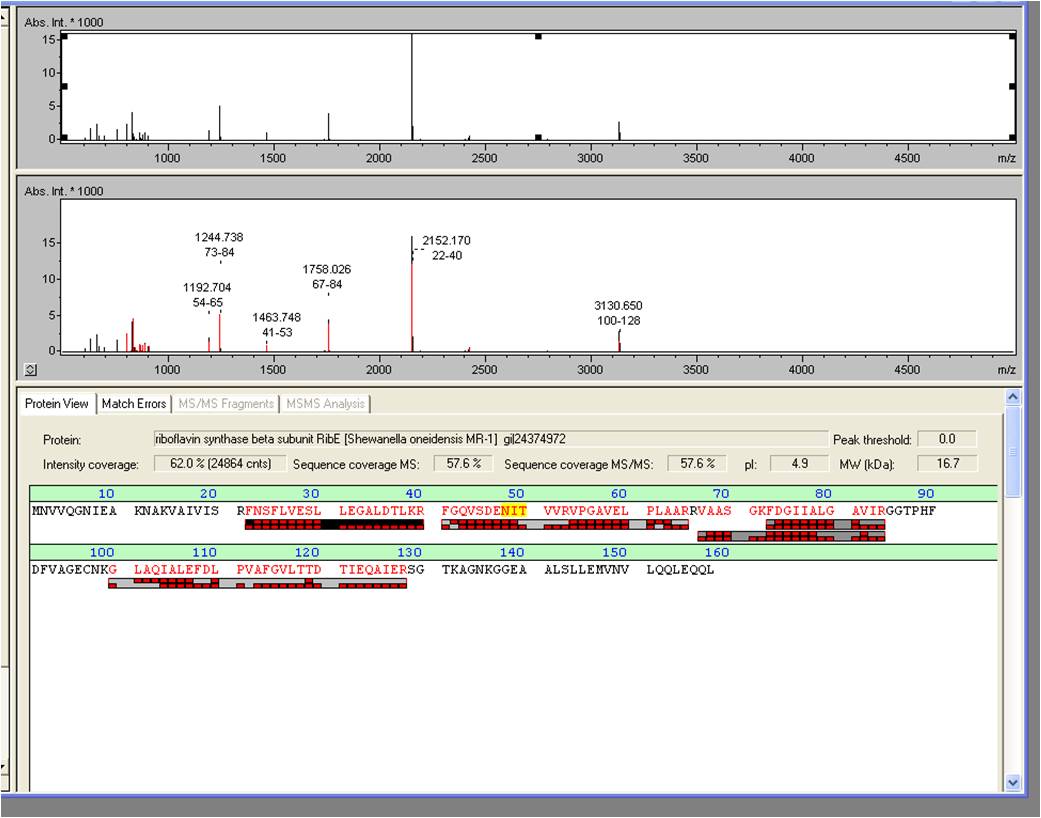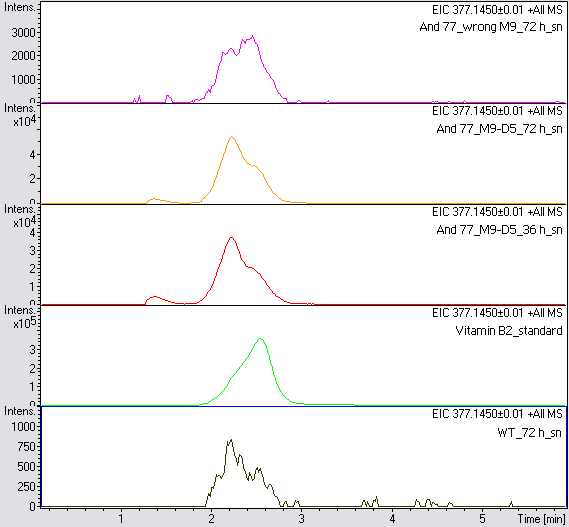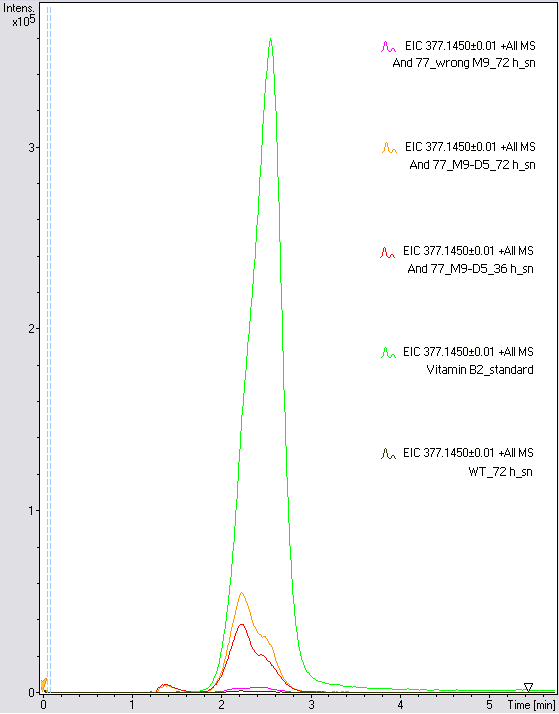Team:Bielefeld-Germany/Labjournal/October
From 2013.igem.org
October
Milestones
- Successful cultivations of Escherichia coli KRX with OprF and GldA in our Microbial Fuel Cell.
- NADH overproduction for the GldA strain improves extracellular electron transfer mediated by NADH and resulting in an 20 % increased bioelectricity output.
- Escherichia coli KRX with OprF shows 100 % higher voltage and electric charge than E. coli Wildtyp. Electron shuttle-mediated electron transfer across the membrane is greatly improved by heterologous expression of outer membrane porin OprF.
Week 22
Organization
- Wiki freeze is coming on saturday at 5:59 pm. Plannung the last week with tremendous amount of work.
MFC
Mediators
- For testing the genetic engineered system in the Microbial Fuel Cell, we used Escherichia coli KRX with GldA and Lac promotor (<bbpart>BBa_K1172204</bbpart>) in contrast to Escherichia coli KRX Wildtyp. Certainly NADH-assays determined Escherichia coli KRX with GldA and T7 promotor (<bbpart>BBa_K1172203</bbpart>) as the best endogenous mediator producing strain. Unfortunately we could not use this strain due to cultivation problems.
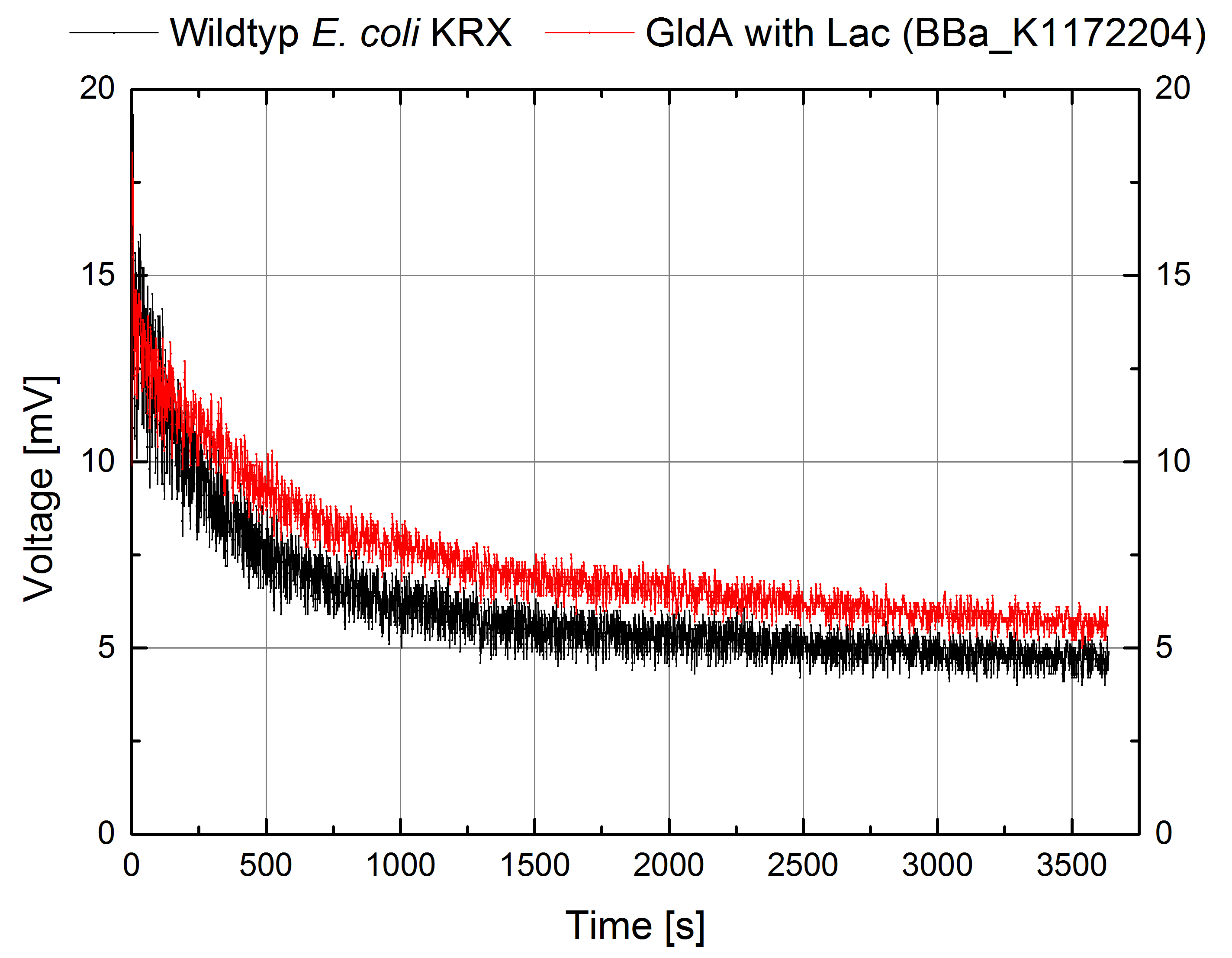
Figure 6: Microbial Fuel Cell results from cultivation of Escherichia coli KRX with GldA (<bbpart>BBa_K1172204</bbpart>) in contrast to Escherichia coli KRX Wildtyp. Voltage curve from Escherichia coli KRX Wildtyp and Escherichia coli KRX with GldA (<bbpart>BBa_K1172204</bbpart>) is shown over time. M9-medium was used with no supplementation of mediators.
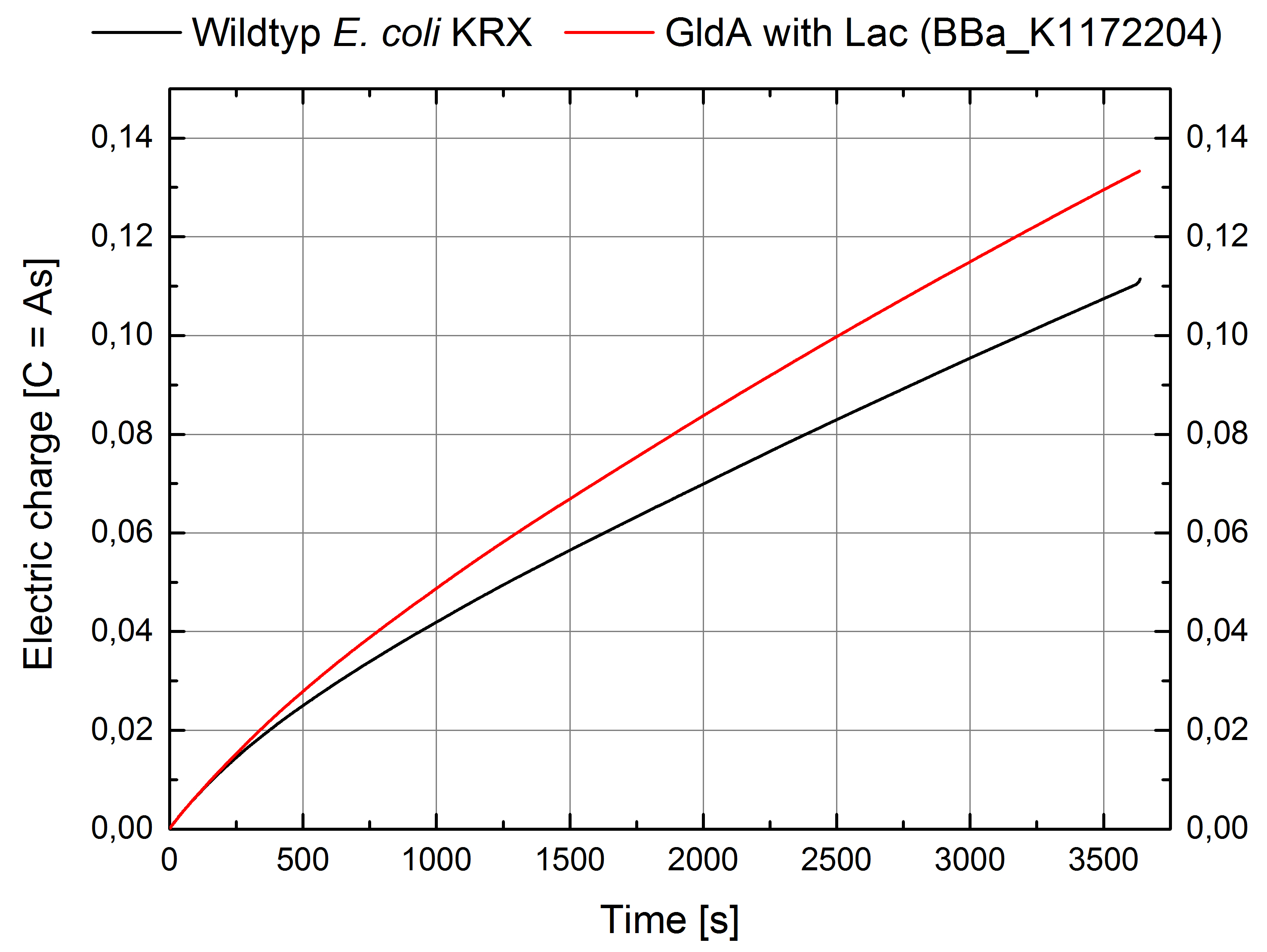
Figure 7: Microbial Fuel Cell results from cultivation of Escherichia coli KRX with GldA (<bbpart>BBa_K1172204</bbpart>) in contrast to Escherichia coli KRX Wildtyp. Electric charge curve from Escherichia coli KRX Wildtyp and Escherichia coli KRX with GldA (<bbpart>BBa_K1172204</bbpart>) is shown over time. M9-medium was used with no supplementation of mediators.
- The extracellular electron transfer mediated by NADH is improved in the GldA strain resulting in an increased bioelectricity output.
Riboflavin
- We received the results from the MALDI-TOF and they where overwhelming. The overexpressed band we cut out from the SDS-PAGE was around 15 DA. We hoped it would turn out to be RibE, with a molecular weight of 16,7 Da.
- We received the results from the MALDI-TOF and they where overwhelming. The overexpressed band we cut out from the SDS-PAGE was around 15 DA. We hoped it would turn out to be RibE, with a molecular weight of 16,7 Da.
- The results show that it is indeed “riboflavin synthase beta subunit ribE” from shewanella oneidensis MR-1. The mascot score was a slick 906. We want to thank Vera for the execution of our measurements.
- Riboflavin synthase beta subunit RibE was examined by MALDI-TOF MS/MS with a Mascot Score of 906 against the NCBI database.
- For further qualitative analysis of riboflavin in our supernatant, we measured fluorescence with the [TECAN-Reader] . The rib-cluster with Anderson77 in the right M9 media has a xxx time higher amount in the supernatant than a wildtype KRX and an xxx higher amount than our probes we had gained from cultures grown in old-M9 (Link to results).
- After it became clear, that the medium had been the problem, we were able to organize another measurement of some of our samples with liquid chromatography-mass spectrometry [(LC/MS)]. We prepared supernatant samples of a wild type KRX after 72 h, our BBa_1172306 strain after 36 h and 72 h in M9-D5 and after 72 h in wrong M9. We than put the samples in the LC-MS-system. The measurement procedure was carried out by Lena Sinkel.
Cytochromes
Biosafety
Porines
- Great results for Escherichia coli KRX with OprF (<bbpart>BBa_K1172502</bbpart>) in contrast to Escherichia coli KRX Wildtyp with Microbial Fuel Cell cultivation.
- According to our assumptions, the extracellular electron transfer mediated by electron shuttles is improved in the OprF strain resulting in an increased bioelectricity output. (Figure 1 and 2)
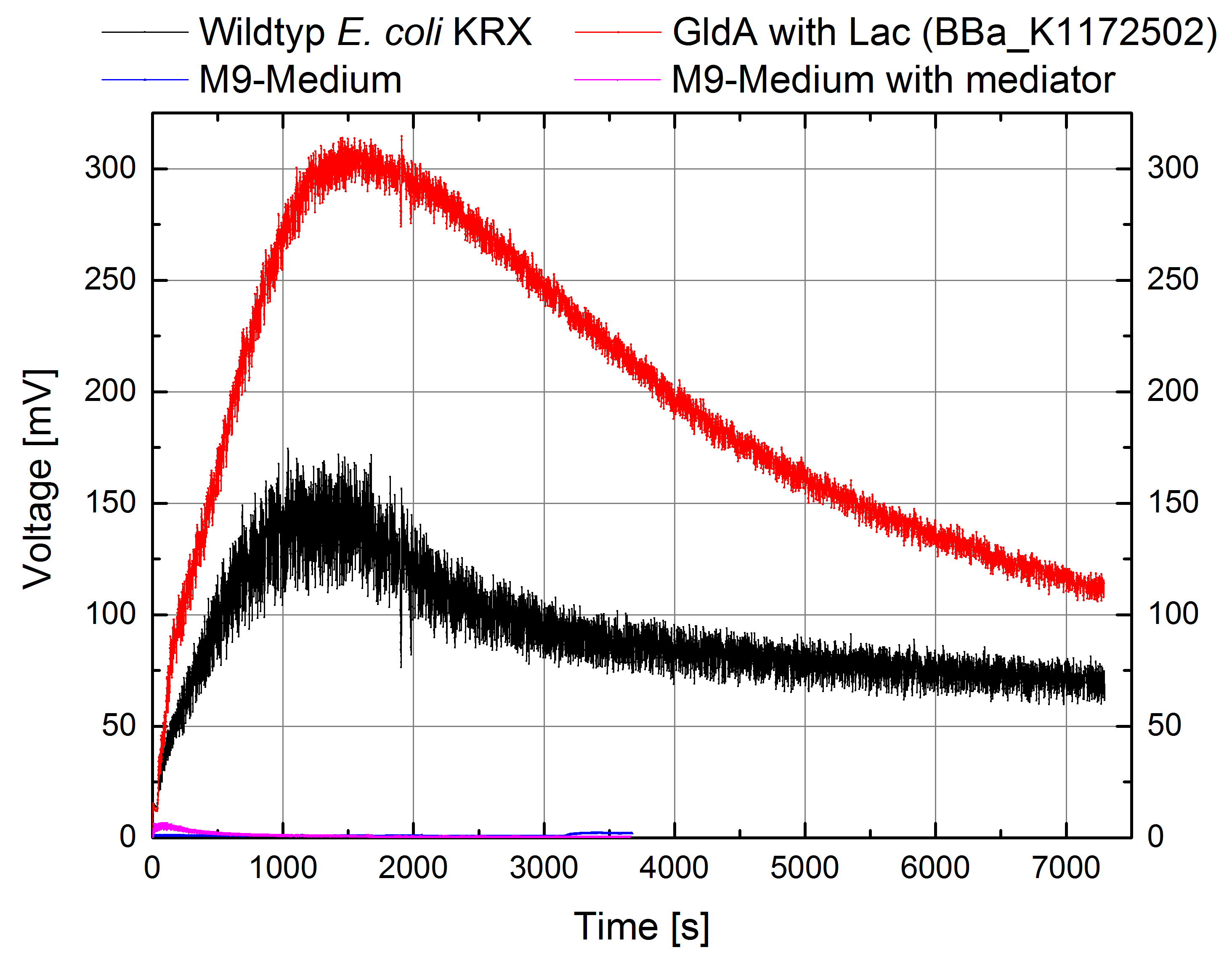
Figure 1: Microbial Fuel Cell results from cultivation of Escherichia coli KRX with OprF (<bbpart>BBa_K1172502</bbpart>) in contrast to Escherichia coli KRX Wildtyp. Voltage curve from Escherichia coli KRX Wildtyp, Escherichia coli KRX with OprF (<bbpart>BBa_K1172502</bbpart>), M9 medium with used mediator New Methylene Blue and M9 medium without mediator is shown over time.

Figure 2: Microbial Fuel Cell results from cultivation of Escherichia coli KRX with OprF (<bbpart>BBa_K1172502</bbpart>) in contrast to Escherichia coli KRX Wildtyp. Electric charge curve from Escherichia coli KRX Wildtyp and Escherichia coli KRX with OprF (<bbpart>BBa_K1172502</bbpart>). M9 medium was used with mediator New Methylene Blue.
- Escherichia coli KRX with OprF (<bbpart>BBa_K1172502</bbpart>) shows 100 % higher voltage and electric charge than E. coli Wildtyp.
Week 23
Organization
MFC
Mediators
Cytochromes
Biosafety
Porines
Week 24
Organization
MFC
Mediators
Cytochromes
Biosafety
Porines
Week 25
Organization
MFC
Mediators
Cytochromes
Biosafety
Porines
 "
"

